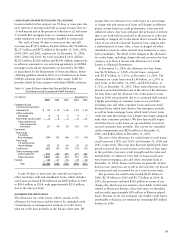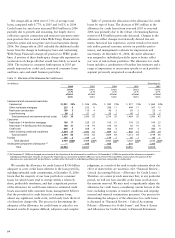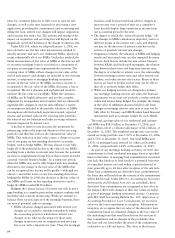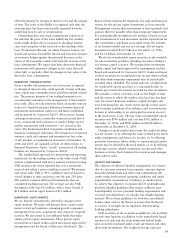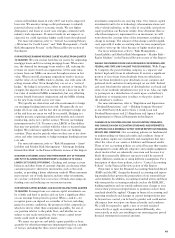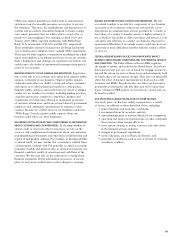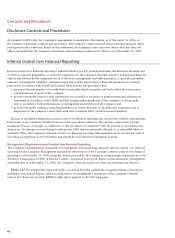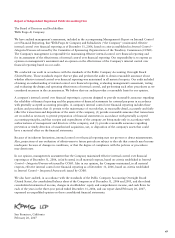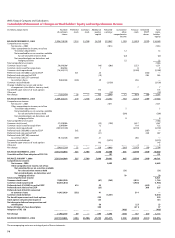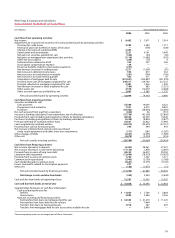Wells Fargo 2006 Annual Report Download - page 65
Download and view the complete annual report
Please find page 65 of the 2006 Wells Fargo annual report below. You can navigate through the pages in the report by either clicking on the pages listed below, or by using the keyword search tool below to find specific information within the annual report.
63
actions will stabilize losses in early 2007 and lead to improved
loss rates. We monitor vintage credit performance to identify
potential adverse credit or economic trends. We saw higher
delinquency and losses in recent auto vintages, consistent with
industry-wide experience. If current trends do not improve as
expected, we could experience higher credit losses than planned.
For more information, refer to “Critical Accounting Policies
– Allowance for Credit Losses” and “Risk Management – Credit
Risk Management Process” in the Financial Review section of
this Report.
OUR MORTGAGE BANKING REVENUE CAN BE VOLATILE FROM QUARTER
TO QUARTER. We earn revenue from fees we receive for originating
mortgage loans and for servicing mortgage loans. When rates
rise, the demand for mortgage loans tends to fall, reducing the
revenue we receive from loan originations. At the same time,
revenue from our MSRs can increase through increases in fair
value. When rates fall, mortgage originations tend to increase
and the value of our MSRs tends to decline, also with some off-
setting revenue effect. Even though they can act as a “natural
hedge,” the hedge is not perfect, either in amount or timing. For
example, the negative effect on revenue from a decrease in the
fair value of residential MSRs is immediate, but any offsetting
revenue benefit from more originations and the MSRs relating
to the new loans would accrue over time.
We typically use derivatives and other instruments to hedge
our mortgage banking interest rate risk. We generally do not
hedge all of our risk, and the fact that we attempt to hedge any
of the risk does not mean we will be successful. Hedging is a
complex process, requiring sophisticated models and constant
monitoring, and is not a perfect science. We may use hedging
instruments tied to U.S. Treasury rates, LIBOR or Eurodollars
that may not perfectly correlate with the value or income being
hedged. We could incur significant losses from our hedging
activities. There may be periods where we elect not to use deriv-
atives and other instruments to hedge mortgage banking interest
rate risk.
For more information, refer to “Risk Management – Asset/
Liability and Market Risk Management – Mortgage Banking
Interest Rate Risk” in the Financial Review section of this Report.
OUR BANK CUSTOMERS COULD TAKE THEIR MONEY OUT OF THE BANK
AND PUT IT IN ALTERNATIVE INVESTMENTS, CAUSING US TO LOSE A
LOWER COST SOURCE OF FUNDING. Checking and savings account
balances and other forms of customer deposits can decrease when
customers perceive alternative investments, such as the stock
market, as providing a better risk/return tradeoff. When customers
move money out of bank deposits and into other investments,
we can lose a relatively low cost source of funds, increasing our
funding costs and reducing our net interest income.
OUR VENTURE CAPITAL BUSINESS CAN ALSO BE VOLATILE FROM QUARTER
TO QUARTER. Earnings from our venture capital investments can
be volatile and hard to predict and can have a significant effect
on our earnings from period to period. When—and if—we
recognize gains can depend on a number of factors, including
general economic conditions, the prospects of the companies in
which we invest, when these companies go public, the size of
our position relative to the public float, and whether we are
subject to any resale restrictions. Our venture capital invest-
ments could result in significant losses.
We assess our private and public equity portfolio at least
quarterly for other-than-temporary impairment based on a number
of factors, including the then current market value of each
investment compared to its carrying value. Our venture capital
investments tend to be in technology, telecommunications and
other volatile industries, so the value of our public and private
equity portfolios can fluctuate widely. If we determine there is
other-than-temporary impairment for an investment, we will
write-down the carrying value of the investment, resulting in a
charge to earnings. The amount of this charge could be signifi-
cant, especially if under accounting rules we were required pre-
viously to write-up the value because of higher market prices.
For more information, refer to “Risk Management –
Asset/Liability and Market Risk Management – Market Risk –
Equity Markets” in the Financial Review section of this Report.
WE RELY ON DIVIDENDS FROM OUR SUBSIDIARIES FOR REVENUE, AND
FEDERAL AND STATE LAW CAN LIMIT THOSE DIVIDENDS. Wells Fargo
& Company, the parent holding company, is a separate and
distinct legal entity from its subsidiaries. It receives a significant
portion of its revenue from dividends from its subsidiaries.
We use these dividends to pay dividends on our common and
preferred stock and interest and principal on our debt. Federal
and state laws limit the amount of dividends that our bank and
some of our nonbank subsidiaries may pay to us. Also, our right
to participate in a distribution of assets upon a subsidiary’s
liquidation or reorganization is subject to the prior claims of
the subsidiary’s creditors.
For more information, refer to “Regulation and Supervision
– Dividend Restrictions” and “– Holding Company Structure”
in our 2006 Form 10-K and to Notes 3 (Cash, Loan and
Dividend Restrictions) and 25 (Regulatory and Agency Capital
Requirements) to Financial Statements in this Report.
CHANGES IN ACCOUNTING POLICIES OR ACCOUNTING STANDARDS,
AND CHANGES IN HOW ACCOUNTING STANDARDS ARE INTERPRETED
OR APPLIED, COULD MATERIALLY AFFECT HOW WE REPORT OUR FINANCIAL
RESULTS AND CONDITION. Our accounting policies are fundamental
to understanding our financial results and condition. Some of
these policies require use of estimates and assumptions that may
affect the value of our assets or liabilities and financial results.
Three of our accounting policies are critical because they require
management to make difficult, subjective and complex judgments
about matters that are inherently uncertain and because it is
likely that materially different amounts would be reported
under different conditions or using different assumptions. For a
description of these three policies, refer to “Critical Accounting
Policies” in the Financial Review section of this Report.
From time to time the Financial Accounting Standards Board
(FASB) and the SEC change the financial accounting and report-
ing standards that govern the preparation of our external finan-
cial statements. In addition, accounting standard setters and those
who interpret the accounting standards (such as the FASB, SEC,
banking regulators and our outside auditors) may change or even
reverse their previous interpretations or positions on how these
standards should be applied. Changes in financial accounting and
reporting standards and changes in current interpretations may
be beyond our control, can be hard to predict and could materi-
ally impact how we report our financial results and condition.
We could be required to apply a new or revised standard
retroactively or apply an existing standard differently, also
retroactively, in each case resulting in our restating prior period
financial statements in material amounts.


